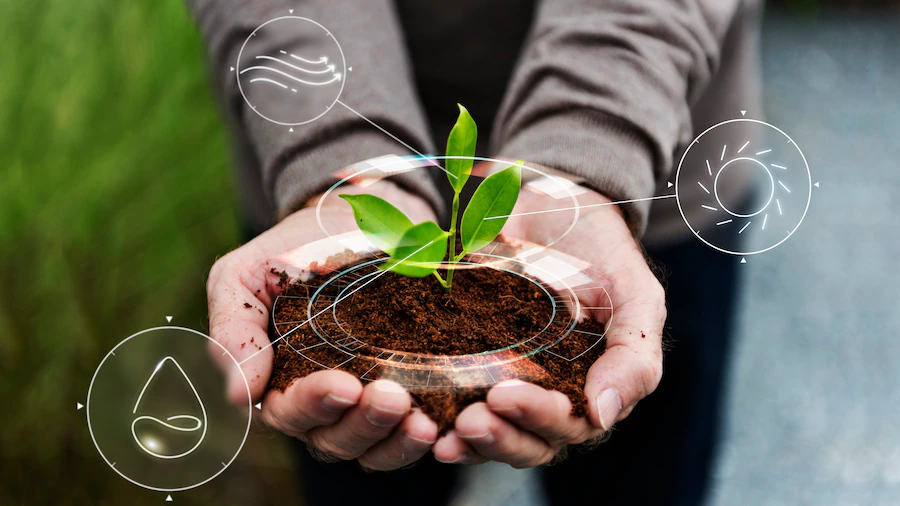Let's Discuss
Enquire NowHave you heard the news about Spinach plants sending emails? No, it’s not a joke. According to a 2016 MIT study, spinach plants can actually send emails to humans.
The tech industry has been experimenting with plants in ways that take advantage of their inherent abilities to benefit humans and kind of enable them to communicate with us. The field of technology that deals with this are known as Plant Nanobionics.

Plant nano bionics is a branch of research that focuses on implanting nanoparticles or other nanostructures into the cells or bodies of plants which equip them with special characteristic abilities. To make it more interesting, you can think of the plant as Peter Parker and the nanoparticles as the spider that bit him.
These nanoparticles can alter how a particular area or organelle of the plant naturally functions. The larger goal is to develop a monitoring system that will allow plants to independently monitor their surroundings, power gadgets with their own energy, and communicate with people by triggering devices that are connected to them for this purpose. In the case of the spinach we mentioned above, researchers obtained an email alert when toxins built up in the soil where it was planted.
Let’s look at the spinach experiment in detail.
MIT scientists have worked on developing plants with enhanced photosynthetic capability by embedding nanostructures inside their cells, allowing these not only to absorb 30% more energy from sunlight but also to detect pollutants.
In the spinach experiment, scientists inserted single-walled carbon nanotubes and fluorescent nanosensors into the spinach plant’s mesophyll, the dense core portion of the leaf. Nitro aromatics, which are toxic substances found in industrial waste and explosives, frequently leak into the soil through groundwater and surface water. They get absorbed into the plant system through roots. Following transpiration, when water is discharged from the leaves as water vapour, these toxins get accumulated on the mesophyll layer of leaves. As the toxic pollutant nitrogen dioxide builds up above a certain concentration in the mesophyll, a signal is emitted which triggers a pre-programmed email alert. This is one use case of plant nano bionics by which the soil contents and pollution levels can directly be monitored using plants.
Since plants are quick to react to environmental changes, researchers believe that plant nano bionics could also be used to monitor the environment. It may also contribute to the development of biomimetic materials for light-harvesting and biochemical detection with regenerative properties and enhanced efficiency. Additionally, they can generate their own energy through photosynthesis which can be used to power these sensors constantly without us having to make room for external sources.
Now that we have talked about the spinach that can send emails, let’s talk about another plant that can click selfies!
Pete, a maidenhair fern was made to click regular pictures of itself and its surroundings using energy generated from photosynthesis. So how does this work?
Glucose which is a byproduct of photosynthesis travels back to the soil through roots as a waste product. This glucose is then absorbed by microbes and bacteria, which break it down to generate additional energy that can be used to power microbial cathodes, anodes, and a capacitor. When the microbial cathode is fully charged, it releases a power of roughly 0.1 milliwatts, activating the camera every 20 seconds. This experiment was performed at the Zoological Society of London in 2019.
This technology offers incredible scope for visual monitoring of forests for camera traps and monitoring the environment in ecologically sensitive areas that are inaccessible to humans. It aids tremendously in conservation efforts as well as in tracking and monitoring endangered species.
Nanotechnology holds great promise for developing unique and enhanced functional features in photosynthetic organelles and organisms to improve solar energy absorption. The aim is to devise sensors that when incorporated into plants, could allow us to monitor pesticide use alternatively and effectively, and discover infections due to fungi or bacterial toxins. The nano bionics approach will lead to a new area of research at the interface of nanotechnology and plant biology.
At Dexlock we ensure to keep ourselves on track with the latest updates from the tech world. We make it a point to arm ourselves with the upcoming technologies in order to provide the best service to our clients. We believe in creating a futuristic world together with visionaries like us. Connect with us here for more.
Disclaimer: The opinions expressed in this article are those of the author(s) and do not necessarily reflect the positions of Dexlock.



